The camerawork in this opening sequence is used to create a confusion for the viewer although some shots are shown as a sense of normality which contrasts with one another. We are shown a mid shot of an older man who appears to be telling the story, this is for the viewer to become familiar with who this old man is and why he is telling a story. Throughout the scene we are shown mid shots/ close ups of the main characters in the sequence, this is done to show the viewer a clearer image of the protagonists. We are also shown an extreme long shot of the hall and stage in which the magic tricks are being peformed, this just widens the view of the location and who is involved in this particular scene. Many shots are quick and they tend to switch from one another often, this is typical of a thriller as it creates confusion and mystery for the viewers, it draws them in and makes them want to watch more.
The editing in this sequence is continuity editing as it mainly uses cuts to switch from one scene into another, however it doesnt seem to use any fades or dissolves. This is done so it feels as though the sequence is quite quick and the transitions move from one to another quickly. As the sequence swithes from one location to another without any transition it feels as though it's going back in time and showing a flashback of the past. By doing this the viewer feels disorientated, they feel as though the sequence is being rushed, or even missing out parts of the story, this intregues the viewer which is sterotypical of a thriller as they now want to watch the rest of the sequence to find out what's happening. Tracking is used in this sequence to follow movements made by a man who appears to be suspicious, this is done to feel as though they need to be followed to whereever they are planning on going. This makes the reader feel as though they are invading the privacy of whoever the camera is following as they do not know they are being followed. Zooms are often used in this sequence, usually to show something from a larger view and then zoom in to see it in more detail.
Mise-en-scene is used in this sequence also. The first shot we see in the opening sequence is a shot of many identical top hats, these are shown in a forest. Top hats are usually connected with magicians, so straight away we think that a magic trick may have been taken place to duplicate all of these top hats. There is a slight bit of mystery as to why the hats are in the middle of a dull forest though, this could link to the mystery part of the sequence.
The scene then swaps to an indoor location, the first character we are shown is a man who appears to be a sterotypical granddad. He has very little grey hair, a grey beard and is wearing a shirt and a waistcoat. The clothes he is wearing appears to be very old fashioned which suggest it is set in an earlier time peirod rather than the present day. We are then shown a young girl who could be the granddaughter of the old man, she is wearing and old fashioned dress which is a light pink with ruffles and lace on the neck. After this the scene swaps again to a hall and a stage with a man on who appears to be an entertainer, i say this because he is wearing a suit and bow tie so he appears to be professional and know what he is doing. In his left hand he appears to be holding a walking stick, this could suggest that he needs it for part of his trick.
The lighting in the sequence is very dull and dim, this is done to create atmosphere for the trick on stage and most likely it would have been set to take place in the evening time. But the lighting could also suggest the mood, it could make the audience feel uneasy and think that something bad is going to take place. There is one spotlight on the stage which is pointed at the magician, this shows that he is of higher authority than everyone else but it could also suggest that when the audience all have their eyes on him, something could be taking place elsewhere.
Sound is the last micro element in which uses and explores the thriller conventions. At the start of the sequence there is non-diegetic speech in a low tone which appears to be a mans voice, this makes the audience wonder who's voice it is and why it is done in this way. Throughout the sequence there is speech, the old man speaks the whole way through the sequence, this again is non diegetic speech. This makes the viewer think that the old man is telling a story, maybe to his granddaughter. We also hear diegetic sound which sounds like electric supply and occasionally sounds like thunder, this is done when the helper switches on the big machine in the middle of the stage, the sound is added to make the machine appear scarey and dangerous to the audience which it certianly does. At this point the audience wonder what trick the magician will be carrying out and wether it is safe or not. There is some ambient sound in the sequence, which is a light sound of a machine.
Monday, 28 February 2011
Analysis of thriller opening - The Prestige.
Wednesday, 23 February 2011
Analysis of Thriller Opening - PREMONITION
In Premonition the camerawork is used to create a sense of both confusion and mystery, but also normality. We are introduced into the opening sequence with a high-angle/bird’s eye view shot of the protagonist sat in a stationary car and this is challenging to the viewer seeing as this is not a stereotypical shot in which a scene would be introduced. This is therefore powerful and leaves the viewer unaware of the location and what will happen next. Shots such as over the shoulder shots, medium shots and long shots are used to create a sense of normality in the scene, and are individually used to create different effects. Over the shoulder shots shows the conversation and intimacy between the two characters, medium/close-up shots show the two characters in detail and some location also. Long shots are used to show the location in detail, set the scene and also involve the audience in the scene more. The mix of these shots allows the viewer to engage more fully in the opening sequence. Camerawork uses the conventions of a thriller effectively due to the shots being used to present mystery but also normality to the viewer confusing them and leaving them wondering what will happen next.
Sound is another micro-element which uses and explores thriller conventions. In the opening credits a non-diegetic sinister, orchestral sounding piece of music is played to introduce the titles in a particular way. This use of sound creates tension for the audience and also stereotypically leaves them thinking that something bad/mysterious will happen due to the conventions of thrillers. The use of orchestral sounds and instruments which are played (including strings) emphasise this mysterious and sinister feel due to the tone and effect that they have on an audience. Sound is also used in the opening sequence to create an everyday feel, and sense of normality. This sense of normality and everyday life is portrayed to the audience by using diegetic ambient sounds and also dialogue. Ambient sounds such as the sound of a car, the car door slamming, car keys, birds in trees, the wind are all ambient sounds which are used stereotypically to portray that sense of normality in a film and create atmosphere. Also, when no image is shown and only ambient sounds are played it can give clues to the audience about the setting, location etc. Dialogue (diegetic) is also used to portray normality due to it showing interaction between two characters.
The editing used in the opening sequence of Premonition is particularly significant to the way in which the micro-element explores and uses the conventions of a thriller, especially a psychological one. Firstly fades in and out of the scene are used along with a lighter more dull/washed out coloured effect are used on the clip to create the sense of a flashback, dream or memory that are commencing in the protagonists mind. We are clear that this is a different time in the scene that is trying to be portrayed due to the scene fading out to a bad in which the protagonist wakes up in. The effect is not used in this bed scene. This flashback/memory style of editing is particularly effective as it is a theme that is explored deeply in psychological thrillers and this is a clear example of it being used effectively. It is effective as it makes the viewer wonder which scene is reality and also wonder why it has been shown to them. Other questions can also be drawn up from this leaving the viewer wanting to know more. It is also suggestive that when a memory/flashback is shown at the start of a film that it is significant/important to the story and can also be suggestive of what may happen further in the film. Other editing effects which are used are things such as panning and tracking shots which are both used to portray normality, but can be used to achieve certain effects. Tracking is mainly used to follow the characters movements, which is useful for the audience in being able to pay attention to detail, and follow their movements etc. Panning is mainly used to show a view of some sort, and is slower/more relaxed in order to give the audience more time to take in the surroundings and get a better feel for the story. Continuity style editing is used in the opening sequence to create a sense of normality in which events in the scene happen in the typical way in which they are supposed to. This continuity editing is used in order to not overly confuse the viewer seeing as they are already being challenged to interpret the flashback/memory effect that is shown and how this is used/is significant to the story. This therefore allows the film to be stimulating, yet enjoyable still. The use of the continuity editing does however challenge the thriller conventions. Also, as there is a flashback we assume that some parallel editing would have been used.
Mise-en-scene is also another micro element which uses and explores the conventions of a thriller. In the opening sequence the costumes of the two characters are styled to portray normality. We see these two characters in casual, relaxed styled clothing such as t-shirts, jeans and hoodies. This helps to create a normal, calm sense in which the audience can relate to and understand. It is also particularly effective when other things are going on (strange, bad, mysterious) as the audience then become involved in these things in the scene as they can relate to it. It is therefore more personal on many levels. Makeup is used sparingly to create an everyday look in order to seem as if none is worn. The location used is also typical of a thriller convention as it is a very normal, stereotypical, realistic setting – a typical family neighbourhood. In the scene/shots used we see a middle sized house in an average/fairly wealthy neighbourhood and this along with the two middle aged characters, which are a couple stereotypically suggests family life and in some ways wealth. This is effective as it is something that most viewers can relate to or familiarise with, again creating that sense of normality. Also by the couple making contact and being ‘intimate’ to some extent in the opening sequence when kissing, hugging etc. this could be seen as stereotypical and within all of the normality suggested through the mise-en-scene and other micro elements it could be suggestive that something bad may happen to/in this relationship due to this being a focus in the opening clips shown. Lighting used in the scene is daylight which is used to create an everyday feel which the audience can relate to on a personal level. It can also be overseen by the audience due to the normality of it and this being something that the audience would not pick up on. Lastly, props are used in the opening sequence to set the scene and further portray that sense of normality in everyday life. Props such as a car, house keys, a watch, a hanging basket are all effective in emphasising that sense of normality and everyday life within the scene. They are also effective in making it easier for the audience to relate to and understand. Due to details such as lighting and props being used in the opening sequence to emphasise the normality and everyday feel, it also has a further effect as it emphasises the in-normality of the other corresponding effects/micro-elements used in the scene.
Sound is another micro-element which uses and explores thriller conventions. In the opening credits a non-diegetic sinister, orchestral sounding piece of music is played to introduce the titles in a particular way. This use of sound creates tension for the audience and also stereotypically leaves them thinking that something bad/mysterious will happen due to the conventions of thrillers. The use of orchestral sounds and instruments which are played (including strings) emphasise this mysterious and sinister feel due to the tone and effect that they have on an audience. Sound is also used in the opening sequence to create an everyday feel, and sense of normality. This sense of normality and everyday life is portrayed to the audience by using diegetic ambient sounds and also dialogue. Ambient sounds such as the sound of a car, the car door slamming, car keys, birds in trees, the wind are all ambient sounds which are used stereotypically to portray that sense of normality in a film and create atmosphere. Also, when no image is shown and only ambient sounds are played it can give clues to the audience about the setting, location etc. Dialogue (diegetic) is also used to portray normality due to it showing interaction between two characters.
The editing used in the opening sequence of Premonition is particularly significant to the way in which the micro-element explores and uses the conventions of a thriller, especially a psychological one. Firstly fades in and out of the scene are used along with a lighter more dull/washed out coloured effect are used on the clip to create the sense of a flashback, dream or memory that are commencing in the protagonists mind. We are clear that this is a different time in the scene that is trying to be portrayed due to the scene fading out to a bad in which the protagonist wakes up in. The effect is not used in this bed scene. This flashback/memory style of editing is particularly effective as it is a theme that is explored deeply in psychological thrillers and this is a clear example of it being used effectively. It is effective as it makes the viewer wonder which scene is reality and also wonder why it has been shown to them. Other questions can also be drawn up from this leaving the viewer wanting to know more. It is also suggestive that when a memory/flashback is shown at the start of a film that it is significant/important to the story and can also be suggestive of what may happen further in the film. Other editing effects which are used are things such as panning and tracking shots which are both used to portray normality, but can be used to achieve certain effects. Tracking is mainly used to follow the characters movements, which is useful for the audience in being able to pay attention to detail, and follow their movements etc. Panning is mainly used to show a view of some sort, and is slower/more relaxed in order to give the audience more time to take in the surroundings and get a better feel for the story. Continuity style editing is used in the opening sequence to create a sense of normality in which events in the scene happen in the typical way in which they are supposed to. This continuity editing is used in order to not overly confuse the viewer seeing as they are already being challenged to interpret the flashback/memory effect that is shown and how this is used/is significant to the story. This therefore allows the film to be stimulating, yet enjoyable still. The use of the continuity editing does however challenge the thriller conventions. Also, as there is a flashback we assume that some parallel editing would have been used.
Mise-en-scene is also another micro element which uses and explores the conventions of a thriller. In the opening sequence the costumes of the two characters are styled to portray normality. We see these two characters in casual, relaxed styled clothing such as t-shirts, jeans and hoodies. This helps to create a normal, calm sense in which the audience can relate to and understand. It is also particularly effective when other things are going on (strange, bad, mysterious) as the audience then become involved in these things in the scene as they can relate to it. It is therefore more personal on many levels. Makeup is used sparingly to create an everyday look in order to seem as if none is worn. The location used is also typical of a thriller convention as it is a very normal, stereotypical, realistic setting – a typical family neighbourhood. In the scene/shots used we see a middle sized house in an average/fairly wealthy neighbourhood and this along with the two middle aged characters, which are a couple stereotypically suggests family life and in some ways wealth. This is effective as it is something that most viewers can relate to or familiarise with, again creating that sense of normality. Also by the couple making contact and being ‘intimate’ to some extent in the opening sequence when kissing, hugging etc. this could be seen as stereotypical and within all of the normality suggested through the mise-en-scene and other micro elements it could be suggestive that something bad may happen to/in this relationship due to this being a focus in the opening clips shown. Lighting used in the scene is daylight which is used to create an everyday feel which the audience can relate to on a personal level. It can also be overseen by the audience due to the normality of it and this being something that the audience would not pick up on. Lastly, props are used in the opening sequence to set the scene and further portray that sense of normality in everyday life. Props such as a car, house keys, a watch, a hanging basket are all effective in emphasising that sense of normality and everyday life within the scene. They are also effective in making it easier for the audience to relate to and understand. Due to details such as lighting and props being used in the opening sequence to emphasise the normality and everyday feel, it also has a further effect as it emphasises the in-normality of the other corresponding effects/micro-elements used in the scene.
Thursday, 17 February 2011
POTENTIAL PROBLEMS WITH FLICKERING LIGHTBULB SHOT
The location we are using is a cellar which we need to be almost pitch black. We had decided on using a flickering light bulb as it would be effective for the illusion we wanted to create. We originally wanted a close up of the light bulb, but after discussing it we found that it would be extremely hard and would cause danger to make a light bulb flicker. When carrying out our test shots we found that using a camera torch and swaying it vigerously it gives off a great effect. Also instead of showing a close-up shot of a light bulb we had a idea of using a candle in a lantern which could be flickering by a gush of wind and would eventually blow it.
Labels:
Charlotte Doyle,
Chelsey Madgwick,
Jade Scrivener,
Olie Bill
Tuesday, 15 February 2011
Moodboard
This is our moodboard, we have used two very different sounds and images to give an idea of the two different settings in which we are going to use in the opening sequence. The first set of images are things you would see in a normal family kitchen on a morning before work/school for example; a kitchen table and a kitchen sink. The music is used as we want to create a happy atmosphere to contrast with the dull cellar. The second set of images and sound are complete opposites to the first set as the cellar will be almost pitch black with dull ambient sound and echos. The images used are ideas of shots that we will use for the opening, shot of the eye and tied up hands.
Labels:
Charlotte Doyle,
Chelsey Madgwick,
Jade Scrivener,
Olie Bill
Writing for the thriller opening sequence
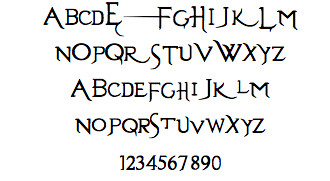
I quite like this font to be used in the opening sequence of the thriller as it is bold yet mysterious, it has a slight curl to it which could suggests that everything isn't as it seems and there is something 'hidden' behind the corner.
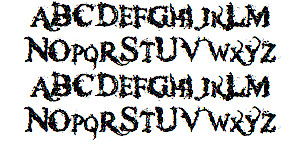
This font looks slightly like blood splattered which i like a lot as is gives a clue as to what the opening sequence is about. It is a little cliche for a thriller but i think it would fit into our story very well but without giving too much away.
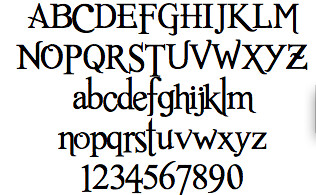
This font is similar to the first font but slightly more sophisticated, this text is quite sharp and pointed which gives off an impression that the sequence will be slightly gory.
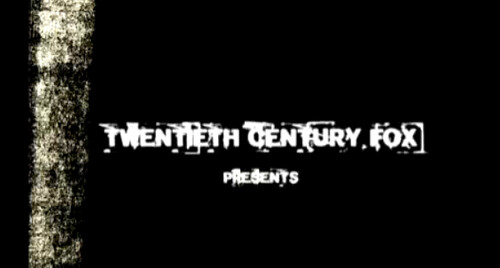
I found this font from an opening sequence on YouTube, this font looks very creepy. I like the way the writing is very square and the white blobs almost make the writing hard to read which makes the viewer pay more attention to the screen. On the video it blurs in and out which I had already imagined our group doing with some writing in the sequence as it would fit in well in the lead up to the cellar scene, this would link to the candle/lantern we are going to use which will be flickering. The stripe down the side looks similar to what the police use to identify finger prints which hints that something suspicious is going to happen which would also fit in with our sequence. This writing is my favourite so far.
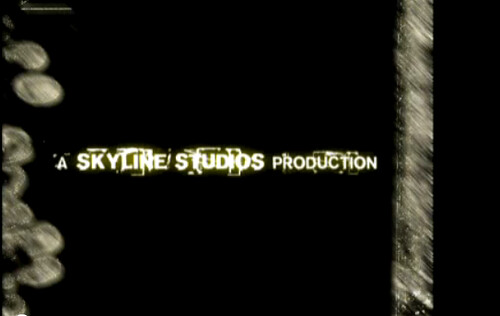
Friday, 11 February 2011
Test Footage
We carried out some test shots before filming our thriller. Part of the opening sequence is going to be set in a dark cellar which is why we chose to do our test shots in a dark room to get the feel of how the shots will look with only a very small amount of lighthing.
In order to create the tension and uncertainty for the audience, we've set the scene in a dark area. The dark room enables the audience to question themselves what is going on and helps set the scene of the girl being vulnerable by not being able to see where she is and being tied up.
The limited light enables the audience to view the protagonist and the main features like the tied hands and feet along with the blood which shows she has been physically harmed and locked up, this creates the effect of the audience being causious of the girls condition making them eel tense, however the audience know sub-consiously that they are safe themselves in reality which is a key feature that thrillers need to include.
The flickering light creates the effect of the light either faiding or about to faid into darkness which helps build the tension for the over all scene. Along with the close up of her face and eye, the flickering light helps create an anxious tension for the audience and helps piece p the scene over all for a thriller as it is subtle.
The ambient sound helps blend in the continuity editing which enables the audience to feel like they're participating in the scene. The dripping water echoing in the background helps set the location of a dark lonely spaced cellar as it echos which makes the location seem very open, this enhances the girl's vulnerability because she is tied in a little space but is kept in a large area. The ambient sound will make the audience feel the echoing is near them like they're there, this effect of continuity editing will help make the "thrill" the audience is hoping to get out of the scene.
Hearing nothing but her breathing and the echoing of the water dripping causes an awkward tension, this blends in with the genre of the sequence because thrillers create and uncertainty to what is and is going to happen, you're never quite sure compared to a horror.
The zoom into a close up of the girl's hands and feet helps show all the main aspects towards the point of the scene which is that she is being held in a cellar tied up.
The mid shot of the girl's face zooming into a close up of just her eye creates tension for the audience as the effect of only seeing one feature of the girl's face, not being able to see her facial expression or where she is creates that uncertainty and curiosity for the audience to build up the effect of the "thrill" that may or not happen at that precise moment. The flickering light and echoing sound effect of dripping water helps to build that effect for the audience as it all fits the scene together.
The scene shows a shadow over the girl's face which looks at first, like an over the shoulder shot, however the shadow is over the girl's face and you don't see anyone's shoulder, this creates the "thrill" for the audience as it's unexpected, to see a shadow of another person appear on the wall and across the girl's face. The audience will because anxious and unsure of what's happening but still sub-consiously know they're not in danger in reality, however the way the camera is shot close to the girl and then shown a shadow of another person makes the audience feel like the shadow is behind them with the effect of continuity editing which enables the audiences to feel they're part of the action.
Labels:
Charlotte Doyle,
Chelsey Madgwick,
Jade Scrivener,
Olie Bill
PROPS AND COSTUMES
Our opening sequence only involves only one main character, but this character is shown in two different locations. For each of these locations the character will need two different costumes.
The main character Lola - For the first location which will be the cellar. Lola will be dressed in old and worn clothes which will be dirty and have holes/ rips in them. The clothes she will be wearing will be a pair of black leggings and a t-shirt. She will have bruises on her face and body and will be dirty all over as well. She will be bare foot in the cellar to show the dirtiness of the environment. Her hair will be down and messy to show she has been neglected for a while.
For the kitchen location Lola will look very smart and sophisticated, she will be wearing a black pencil skirt, a shirt, tights and a pair of heels. She will be carrying a large handbag which shows she is off to work. Her make up will be natural and her hair will be down and straight. This will contrast completely to Lola's cellar look and confuse the audience, and leave them unsure whether it is the same character.

Character no2: This character will have a casual everyday look to contrast with the smartness and sophistication of Lola's look. This will also make the character appear more laid back, and casual compared to the protagonist who appears more in a hurry to show her busy lifestyle. The character could also possibly be a younger child around the age of 1, and in this instance this child will be used to again portray the busy everyday lifestyle of a working mother and wife and give across a sense of normality to the audience.
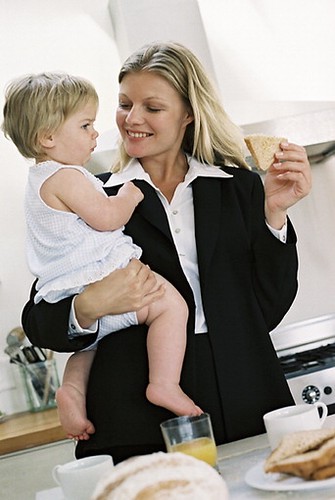

The main character Lola - For the first location which will be the cellar. Lola will be dressed in old and worn clothes which will be dirty and have holes/ rips in them. The clothes she will be wearing will be a pair of black leggings and a t-shirt. She will have bruises on her face and body and will be dirty all over as well. She will be bare foot in the cellar to show the dirtiness of the environment. Her hair will be down and messy to show she has been neglected for a while.
For the kitchen location Lola will look very smart and sophisticated, she will be wearing a black pencil skirt, a shirt, tights and a pair of heels. She will be carrying a large handbag which shows she is off to work. Her make up will be natural and her hair will be down and straight. This will contrast completely to Lola's cellar look and confuse the audience, and leave them unsure whether it is the same character.

Character no2: This character will have a casual everyday look to contrast with the smartness and sophistication of Lola's look. This will also make the character appear more laid back, and casual compared to the protagonist who appears more in a hurry to show her busy lifestyle. The character could also possibly be a younger child around the age of 1, and in this instance this child will be used to again portray the busy everyday lifestyle of a working mother and wife and give across a sense of normality to the audience.


Labels:
Charlotte Doyle,
Chelsey Madgwick,
Jade Scrivener,
Olie Bill
Thursday, 10 February 2011
Test shot pictures
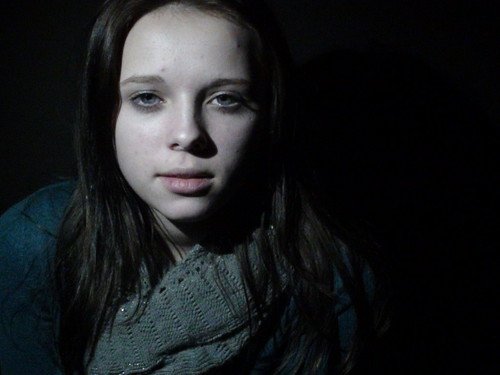
This photo is an example of the shot we will show of the protagonist when we switch back to the cellar scene, it will show the protagonists face which will have a worried expression on it. We tested out lighting to find out what effect looked better with this shot and we found that the lighting used in the picture above would be appropriate.

This shot was tested as we wanted to show close up shots of the eye at the very start of the opening of the sequence. This shot ended up blurry but we liked the effect of this photo so it may be used in the opening. The one below shows a similar shot but it is not blurry, this gives off a mysterious effect which is the effect we want to give off in the opening of the sequence .
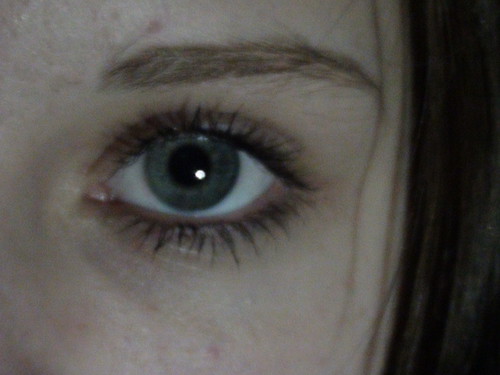
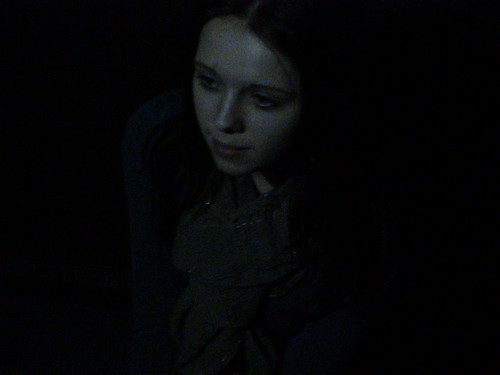
This is a high angle shot shown of the protagonist which we tested as we wanted the setting to be pitch black but we wanted to show part of the protagonists face. We liked the darkness of this as only parts of the protagonists face are shown.
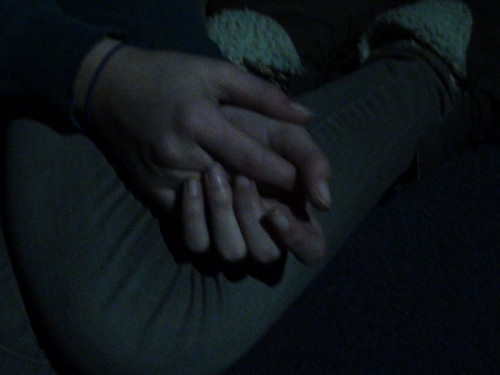
This is a shot of the protagonists hands which will be tied up by rope in the shooting of the opening. This is going to be shown in a flash with the close up of the eye to show a disorientated effect.
Labels:
Charlotte Doyle,
Chelsey Madgwick,
Jade Scrivener,
Olie Bill
Friday, 4 February 2011
SHOT LIST
Here is a rough shot list that we will use in our Thriller.
SHOT 1: INT. Close-up shot of a flickering light bulb (this will be in the cellar - the audience will be unaware of this) - diegetic music of a light bulb flickering.
SHOT 2: Switch to a close-up shot of a wall with blood and dirt splattered all over it, not a focused shot so the viewers are not sure what to think. Here will be a non-diegetic ambient humming sound which the viewers are unsure of what it is/where its from
SHOT 3: diegetic music of a tap dripping in the background of the scene. Here to accompany this sound will be a close-up of a drip, and it hitting the floor.
SHOT 4: Another close-up but this time it would also be a canted angle. It will be of some tied up rope around the protagonists wrists but the shot will not show anything else. The diegetic music of the dripping tap will be carried on throughout this scene.
SHOT 5: The last shot will be an extreme close-up of the protagonists eye, battered and bruised, and with blood running from a cut underneath. The extreme close up will show the detail of the eye, and it twitching and staring blankly into the camera. This will scare the audience and leave them feeling uneasy. The sound here will either be a diegetic ambient sound, or dripping sound.
SHOT 6: The next shot will change the location to the kitchen where we will do an close-up shot of a dripping tap into a sink, this will cause distortion for the viewer so they think that maybe it is the same location as before but in a different time period.
SHOT 7: A close up shot of the radio will be shown so the viewers know where the music is coming from.
SHOT 8: The next shot will change to the kitchen table where there will be a medium shot of the protagonist sat at eating breakfast and talking to a family member/ friend. The music will be diegetic music of a radio which is also sat at the table. This shot will create a sense of normality for the viewer.
SHOT 9: This will show an over the shoulder shot as a conversation between the two characters sat at the kitchen table will be taking place.
SHOT 10: There will then be a tracking shot of the protagonist walking to the sink to put her bowls into the sink and then makes her way out of the house on her way to work.
SHOT 11: When the protagonist has walked out of the house the shot will move to a close up of the calender on the wall with the date monday 9th of March circled and all the days leading up to it crossed out, which shows today is a significant day.
SHOT 12: The location then switches back to the cellar with the protagonist tied up and a medium/close up shot of the protagonists face is shown with dirt over it and looking like a gorm. The protagonist stares into the camera lifelessly.
SHOT 13: A medium high angle shot of the protagonist sitting/lying on the floor is used to show her surroundings in more detail.
SHOT 14: We then hear a non-diegetic sound of footsteps upon the floorboards above, and the the camera switches to point of view shot, showing the protagonists viewpoint and how her vision darts around the room following the movement of the footsteps etc.
SHOT 15: A Close-up shot of the bottom of the door and the light that peaks through from underneath it is shown. We see some of this light blocked, which is presumed to be somebody who lurks behind the door.
SHOT 16: The shot then switches back onto the protagonist with a medium/close-up shot showing her with her head covered by her hands/knees/hair. There will be a diegetic sound of the door open and somebody walking into the room slowly. From the light reflected on the wall behind the protagonist we see the figure of a shadow.
SHOT 1: INT. Close-up shot of a flickering light bulb (this will be in the cellar - the audience will be unaware of this) - diegetic music of a light bulb flickering.
SHOT 2: Switch to a close-up shot of a wall with blood and dirt splattered all over it, not a focused shot so the viewers are not sure what to think. Here will be a non-diegetic ambient humming sound which the viewers are unsure of what it is/where its from
SHOT 3: diegetic music of a tap dripping in the background of the scene. Here to accompany this sound will be a close-up of a drip, and it hitting the floor.
SHOT 4: Another close-up but this time it would also be a canted angle. It will be of some tied up rope around the protagonists wrists but the shot will not show anything else. The diegetic music of the dripping tap will be carried on throughout this scene.
SHOT 5: The last shot will be an extreme close-up of the protagonists eye, battered and bruised, and with blood running from a cut underneath. The extreme close up will show the detail of the eye, and it twitching and staring blankly into the camera. This will scare the audience and leave them feeling uneasy. The sound here will either be a diegetic ambient sound, or dripping sound.
SHOT 6: The next shot will change the location to the kitchen where we will do an close-up shot of a dripping tap into a sink, this will cause distortion for the viewer so they think that maybe it is the same location as before but in a different time period.
SHOT 7: A close up shot of the radio will be shown so the viewers know where the music is coming from.
SHOT 8: The next shot will change to the kitchen table where there will be a medium shot of the protagonist sat at eating breakfast and talking to a family member/ friend. The music will be diegetic music of a radio which is also sat at the table. This shot will create a sense of normality for the viewer.
SHOT 9: This will show an over the shoulder shot as a conversation between the two characters sat at the kitchen table will be taking place.
SHOT 10: There will then be a tracking shot of the protagonist walking to the sink to put her bowls into the sink and then makes her way out of the house on her way to work.
SHOT 11: When the protagonist has walked out of the house the shot will move to a close up of the calender on the wall with the date monday 9th of March circled and all the days leading up to it crossed out, which shows today is a significant day.
SHOT 12: The location then switches back to the cellar with the protagonist tied up and a medium/close up shot of the protagonists face is shown with dirt over it and looking like a gorm. The protagonist stares into the camera lifelessly.
SHOT 13: A medium high angle shot of the protagonist sitting/lying on the floor is used to show her surroundings in more detail.
SHOT 14: We then hear a non-diegetic sound of footsteps upon the floorboards above, and the the camera switches to point of view shot, showing the protagonists viewpoint and how her vision darts around the room following the movement of the footsteps etc.
SHOT 15: A Close-up shot of the bottom of the door and the light that peaks through from underneath it is shown. We see some of this light blocked, which is presumed to be somebody who lurks behind the door.
SHOT 16: The shot then switches back onto the protagonist with a medium/close-up shot showing her with her head covered by her hands/knees/hair. There will be a diegetic sound of the door open and somebody walking into the room slowly. From the light reflected on the wall behind the protagonist we see the figure of a shadow.
Labels:
Charlotte Doyle,
Chelsey Madgwick,
Jade Scrivener,
Olie Bill
Wednesday, 2 February 2011
Why "Thrillers" Thrive...
Thrillers are used to create situations for the audience that they don't actually experience in their own lives. These experiences can create situations which consist of emotional disturbances which can be know as 'thrills'. Thrillers are often seen as unpredictable compared to 'thills' for the audiences everyday life, this is why thrillers are made. To make a fake or artifical experiences by creating thrillers.
Using the stage or the cinema can make it feel less personal, know that it is just a play or film and that you're safe knowing that nothing will actually physically effect you, but then making it so powerful to feel realistic. Thrillers make the audience feel involoved in the film, making them less of a spectator and almost their own character. Making the audience go through the different emotions that are involoved in the film or play is a good thriller. But then if you make the audience actually go through a physical thrill, this does not work as effectively. Meaning that the cinema is somewhere safe and secure for the audience and they know subconsiously that they are safe.
The audience thrives for thrills, the cinema thrives on the audience, the director thrives on the cinema and everybody is happy.
Using the stage or the cinema can make it feel less personal, know that it is just a play or film and that you're safe knowing that nothing will actually physically effect you, but then making it so powerful to feel realistic. Thrillers make the audience feel involoved in the film, making them less of a spectator and almost their own character. Making the audience go through the different emotions that are involoved in the film or play is a good thriller. But then if you make the audience actually go through a physical thrill, this does not work as effectively. Meaning that the cinema is somewhere safe and secure for the audience and they know subconsiously that they are safe.
The audience thrives for thrills, the cinema thrives on the audience, the director thrives on the cinema and everybody is happy.
Tuesday, 1 February 2011
MEMENTO - OPENING SEQUENCE ANALYSIS
Throughout the opening sequence of memento all of the psychological thriller conventions are explored in one way or another. The central theme of identity is explored to some extent. In the opening sequence the characters identity is exploited through inking on his skin which is shown. This inking signifies the characters flaw of having a bad memory and also the mystery surrounding why the character has these inkings. The point of view shots which are used at the beginning of the opening sequence when the character is in the hotel room build suspense and draw the viewer in. It also makes them question what is happening and the reasons behind it. It also portrays the main character to be confused having a loss of memory, and also makes the viewer wonder if the central character even knows his own identity.
Memory is portrayed in Memento in an interesting way. The main character is shown having pieces of information written on his hands. Although the viewer can't actually read what is written it makes them question what is written and draws them in. It also signifies that he does have a memory problem and therefore uses his body as a canvas for these tattoos in order to remember things that he would not remember. Also in the opening sequence close-up shots are used of the main characters face and these show cuts and bruises which he has on it. These cuts and bruises suggest that the character is vulnerable and suggests his weakness of having no memories, as he would not be able to remember why he got these cuts and bruises or what happened to him for them to appear.
A stream of consciousness is shown in Memento as a voice over, this is shown when the protagonist is in the hotel room alone and the voice over is shown as his internal thoughts. This makes us as the viewer feel as though we are getting an insight into things we shouldn't be, so we feel very privileged.
In memento music is a key convention as it sets the atmosphere, the music is very dramatic and mysterious which makes the viewer feel unsure of what is going to happen. It is also used to build up suspense which most thrillers do, the music will start off quiet and slow and gradually build it up until it is at a point in which makes the viewer feel tense and wanting to watch more of the film. String instruments are often used in the music.
In memento mise en scene is giving the audience hints as to what the protagonist is like, the portagonist is shown with writing all over his hand which suggests that he is forgetful and has to make a note on an obvious place to remember important things. Not just does he write things on himself but also he has them tattoed, this is a big clue which makes the audience think that the protagonist has some kind of memory loss an feels the need to tattoo important dates onto his body which is very odd characteristic.
Memento sets up something which is called a 'set of intrigues' this means clues which eventually lead to a bigger puzzle, examples of this is the tattoos he has on himself and the cuts and bruises on his face which suggests he has been fighting. The cuts could either mean that he is a vulnerable character or a strong, tough character; these are made obvious with the other things in which he does and how he is portrayed.
In memento there are many 'point of view' shots used, the reason for this is so the viewer can see through the protagonist's eyes and make themselves feel as though they are in that situation. When the protagonist is shown in the hotel room we are made to think that the protagonist is confused of where he is and maybe even who he is.
Later in the sequence we are shown a close up of a photograph which is in the protagonists hand, this gives the viewer a voyeuristic feel and makes us feel privilaged to be seeing this photograph.
In memento the sense of time is disrupted which makes the viewer feel confused as to what's happening at what time. It even makes the viewer question whether the protagonist is aware of what the time is and where he's going.
In the opening sequence it signals to the viewer what the rest of the film will be about and what to expect, in memento these are:
- distortion of reality
- disruption of time
- repitition
- loss of memory
The fact that the protagonist corrects his name in the opening sequence makes us think that maybe he has a dual identity as people know him as two different names. We also question wether the narrator is reliable as they are asking alot of questions which confuse the viewer.
A stream of consciousness is shown in Memento as a voice over, this is shown when the protagonist is in the hotel room alone and the voice over is shown as his internal thoughts. This makes us as the viewer feel as though we are getting an insight into things we shouldn't be, so we feel very privileged.
In memento music is a key convention as it sets the atmosphere, the music is very dramatic and mysterious which makes the viewer feel unsure of what is going to happen. It is also used to build up suspense which most thrillers do, the music will start off quiet and slow and gradually build it up until it is at a point in which makes the viewer feel tense and wanting to watch more of the film. String instruments are often used in the music.
In memento mise en scene is giving the audience hints as to what the protagonist is like, the portagonist is shown with writing all over his hand which suggests that he is forgetful and has to make a note on an obvious place to remember important things. Not just does he write things on himself but also he has them tattoed, this is a big clue which makes the audience think that the protagonist has some kind of memory loss an feels the need to tattoo important dates onto his body which is very odd characteristic.
Memento sets up something which is called a 'set of intrigues' this means clues which eventually lead to a bigger puzzle, examples of this is the tattoos he has on himself and the cuts and bruises on his face which suggests he has been fighting. The cuts could either mean that he is a vulnerable character or a strong, tough character; these are made obvious with the other things in which he does and how he is portrayed.
In memento there are many 'point of view' shots used, the reason for this is so the viewer can see through the protagonist's eyes and make themselves feel as though they are in that situation. When the protagonist is shown in the hotel room we are made to think that the protagonist is confused of where he is and maybe even who he is.
Later in the sequence we are shown a close up of a photograph which is in the protagonists hand, this gives the viewer a voyeuristic feel and makes us feel privilaged to be seeing this photograph.
In memento the sense of time is disrupted which makes the viewer feel confused as to what's happening at what time. It even makes the viewer question whether the protagonist is aware of what the time is and where he's going.
In the opening sequence it signals to the viewer what the rest of the film will be about and what to expect, in memento these are:
- distortion of reality
- disruption of time
- repitition
- loss of memory
The fact that the protagonist corrects his name in the opening sequence makes us think that maybe he has a dual identity as people know him as two different names. We also question wether the narrator is reliable as they are asking alot of questions which confuse the viewer.
Labels:
Charlotte Doyle,
Chelsey Madgwick,
Jade Scrivener,
Olie Bill
RISK ASSESSMENT
Labels:
Charlotte Doyle,
Chelsey Madgwick,
Jade Scrivener,
Olie Bill
key points of 'why thrillers thrive'
We have to experience thrills artificially and the screen is the best medium for us to do this. For us to appreciate what a character on stage is going through we have to receive thrills vicariously, which is not the best method. The cinema can leave the spectator with a subconscious assurance of safety and yet surprise his/her imagination into playing tricks on them. Scenes in which set the blood pounding through the veins are highly beneficial for indigestion, gout, rheumatism, sciatica and premature middle age. But the 'horror' film has been loosely applied to films which exploit sadism, perversion, bestiality and deformity. This is wrong, being vicious and dangerous. A film can fully well be horrific, but not horrible. Producers of horrible films realize that there is a growing body of opinion inside and outside the film industry so they 'tone down' their product to make it acceptable. A 'thriller' must be whole hearted, the more exciting the better. That is why the authentic 'thriller' will live and thrive and the 'horror' film will die.
Subscribe to:
Posts (Atom)






